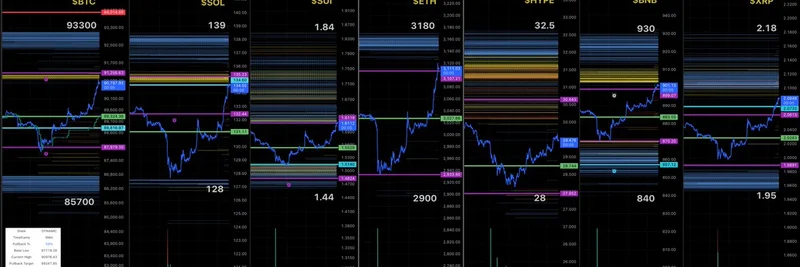Hey there, crypto enthusiasts! If you're scrolling through X (formerly Twitter) and stumbled upon a post from BSCNews about Mitosis ($MITO), you're not alone. The tweet from @BSCNews is buzzing with questions like, "Is @MitosisOrg positioned to revolutionize the way we see liquidity in decentralized finance?" And it links straight to an in-depth article on bsc.news. Let's break this down in simple terms and explore why this could be a game-changer for DeFi, especially if you're into meme tokens and blockchain tech.
Understanding Mitosis: The Basics
Mitosis isn't just a biology term for cell division— in the crypto world, it's an L1 blockchain built on the Cosmos SDK with EVM compatibility. Think of it as a smart network designed to fix one of DeFi's biggest headaches: liquidity fragmentation. In plain English, liquidity is the ease with which you can buy or sell assets without massive price swings. Traditional DeFi often locks your funds in rigid positions, making it hard to move them around or access better yields.
Mitosis changes that by turning liquidity positions into "programmable" assets. This means your deposited funds aren't stuck; they can be traded, used as collateral, or even split into principal and yield components. It's like giving your money superpowers in a multi-chain universe, where blockchains like Ethereum, Arbitrum, and others don't always play nice together.
Key Features That Stand Out
Let's dive into what makes Mitosis tick, based on the details from the BSCNews article.
Mitosis Vaults and Cross-Chain Magic
Users start by depositing assets—like stablecoins or ETH—from various chains into Mitosis Vaults. These vaults generate "Hub Assets" on the Mitosis Chain, acting as your ticket to cross-chain yields. The Cross-Chain Deposit Module (CCDM) is the hero here, pulling in earnings from multiple networks without needing risky bridges. Currently, it supports assets across nine chains, and you can track the Total Value Locked (TVL) right on their app.
This setup is super relevant for meme token holders. Meme coins often thrive on hype and quick trades, but liquidity silos can kill the vibe. Mitosis helps pool resources, making it easier for communities to maintain strong liquidity across ecosystems.
Ecosystem-Owned Liquidity (EOL)
Here's where it gets community-focused. EOL lets users collectively manage and allocate capital through governance votes. When you participate, you get miAssets—programmable tokens that represent your share. These can be traded, loaned out, or decomposed to separate your initial deposit from the earned yields.
Imagine a meme token community using EOL to negotiate better deals with exchanges or protocols. It's democratizing high-yield opportunities that were once reserved for whales (big investors).
The Matrix System
Not the movie, but a curated set of campaigns with partner protocols like Theo and Morph. Deposit into Matrix, and you earn maAssets, which come with perks like early withdrawals (with a small penalty) and exclusive entry gates for committed users. Recent additions include specialized vaults like Zootosis for boosted yields.
This structured approach adds flexibility, perfect for experimenting with DeFi strategies without getting overwhelmed.
How Does It All Work?
It's straightforward: Deposit into a vault, get Hub Assets, then choose EOL for community-driven decisions or Matrix for predefined programs. The platform's sync mechanism tracks everything in real-time—yields, losses, bonuses—ensuring transparency. On top of that, programmable tokens open doors to advanced plays, like building layered DeFi products or swapping strategies via Chromo Exchange.
For blockchain practitioners, this means more efficient capital use. No more locked funds gathering dust; everything is dynamic and composable.
Tokenomics and Governance
The native token is $MITO, though full details aren't public yet. What we know is that MITO Points play a role in rewards and governance, especially in EOL where holders vote on asset allocations. This community-centric model aligns perfectly with meme token vibes—empowering users to shape the project's direction.
Mitosis has solid backing too: A $7 million seed round in May 2024 from investors like Amber Group and Foresight Ventures. The team, led by CEO Jake Kim and based in South Korea, has handled over $100 million in assets with no major red flags.
Why This Matters for Meme Tokens
While Mitosis isn't a pure meme token, its programmable liquidity could supercharge meme projects. Think about it: Better cross-chain access means more trading volume, fairer yields, and stronger communities. In a world where meme coins like Dogecoin or Shiba Inu rely on liquidity for survival, tools like Mitosis could prevent rug pulls and enhance sustainability.
The BSCNews tweet highlights this potential revolution, and with TVL climbing as of July 2025, it's worth watching. If you're building or investing in blockchain, check out the Mitosis Litepaper for deeper dives.
Wrapping Up
Mitosis ($MITO) is positioning itself as a fresh take on DeFi liquidity, blending tech smarts with user empowerment. Whether you're a meme token maximalist or a DeFi degen, this could be the next big thing to add to your radar. Stay tuned for mainnet launches and more integrations— the multi-chain future is here.
For more insights on meme tokens and blockchain news, keep following us at Meme Insider. What's your take on Mitosis? Drop a comment below!

